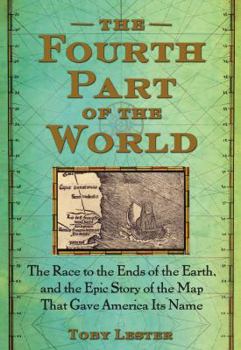The Fourth Part of the World: The Race to the Ends of the Earth, and the Epic Story of the Map That Gave America Its Name
Select Format
Select Condition 
Book Overview
"Old maps lead you to strange and unexpected places, and none does so more ineluctably than the subject of this book: the giant, beguiling Waldseem?ller world map of 1507." So begins this remarkable... This description may be from another edition of this product.
Format:Hardcover
Language:English
ISBN:1416535314
ISBN13:9781416535317
Release Date:November 2009
Publisher:Free Press
Length:462 Pages
Weight:1.85 lbs.
Dimensions:1.3" x 6.5" x 9.3"
Customer Reviews
4 ratings
An epic survey key for both history and general-interest collections
Published by Thriftbooks.com User , 14 years ago
The Fourth Part of the World: The Race to the Ends of the Earth, and the Epic Story of the Map That Gave America Its Name tells of a great map drawn in 1507 that was bought in 2003 by the Library of Congress for, $10 million - the highest price ever paid for a historical document. The map named America and was the first to show the New World as surrounded by water, separate from Asia - but its value lies in more than its depictions. Its history covers world events and crosses continents in an epic survey key for both history and general-interest collections.
A fascinating intellectual journey
Published by Thriftbooks.com User , 14 years ago
In "The Fourth Part of the World: The Race to the Ends of the Earth, and the Epic Story of the Map That Gave America Its Name" Toby Lester uses an obscure map published in 1507 as a springboard to tell a fascinating tale of Medieval maps and exploration. The quest of Medieval Europe to define the world through an adequate map is closely aligned to the quest to explore that world first-hand. Maps and exploration fed one another: new discoveries revising old maps, maps encouraging explorers to look a little harder. Lester shows how various threads of knowledge -- ancient sources such as Ptolemy, philosophical excercises in what the world should look be to reflect religious understanding, marine charts showing coastlines from decades and centuries of practical experience, and reports fresh from wandering explorers -- came together to make possible the first maps to approximate a modern understanding of what the world really looked like.
my favorite book of the year
Published by Thriftbooks.com User , 14 years ago
This is my favorite book of the year. I am giving it to friends and family for Christmas. It is the story of the map that named America -- a remarkable map that is now the central feature in the lobby of the Library of Congress in Washington. But, told engagingly by Toby Lester, it is also a story of intrigue, deception, sex, and bribery -- the story of competition among early explorers and their patrons to find and document ( and mis-document) new worlds. A remarkable achievement.
Enticing
Published by Thriftbooks.com User , 15 years ago
Simon Winchester's review above does not give this book justice, although I must say that Lester's ability to spin a great story around an arcane subject may rival Winchester's. To me this book is about so much more than the naming of America on a map - it is really about the process of discovery and enlightenment and the pitfalls and pratfalls along the way. I ordered the book in an attempt to research an even more arcane issue I did not find in the book, but was immediately captivated by the exposition, and set my current book aside to read this to completion. The title of the book could maybe not be more cryptic or off-putting, but don't let that deter you. The Fourth Part of the World refers to the somewhat mythical, yet actual undiscovered lands (after Asia, Europe and Africa) described by the ancients which we know now as America. Lester spins an exhaustively researched yet page-turning story of how this mythical land was gradually given substance and shape by explorers and cartographers. That the mapmakers at the center of the story write "America" on their map is almost incidental to the story. The great story, which Lester tells so wonderfully well, is how incredibly important world maps effected the philosophy of the day. Lester makes the case that it was this map that caused Copernicus to form his theory of the Universe, which if true, is far more significant than simply naming America. For the average reader like me, this book will fill in a lot of the gaps in your learning about the age of exploration, and possibly give insight to the shortfalls and missteps we continue to repeat while exploring new domains without the proper "map". "The Fourth Part of the World" is truly not an arcane subject, and it's a wonderful read.





